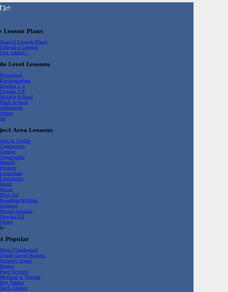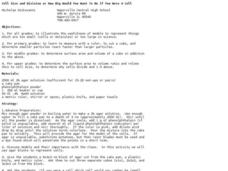Virginia Department of Education
The Ratio of Surface Area to Volume
Demonstrate the ratio of surface area to volume in your high school class by using phenolphthalein, gelatin, and an onion. Intrigue the class by leading a discussion on osmosis and diffusion, then making "scientific jello." Participants...
Curated OER
Sizing Cells
Students examine how living cells reproduce to make new cells. In this cell reproduction lesson plan students complete a lab activity and answer questions.
Nuffield Foundation
Effect of Size on Uptake by Diffusion
Cell size is limited by the surface area to volume ratio, but why is this true? Scholars measure the surface area and volume of cubes before placing them into liquid. After a set amount of time, they measure the uptake by diffusion for...
Virginia Department of Education
The Cell Cycle and Mitosis
What a packed lesson! Provide your class with the opportunity to learn about the cell cycle in several exciting ways. Biologists first learn about the theory behind mitosis, then proceed to view onion tips under the microscope and create...
Curated OER
Surface to Volume Ratios
Students measure the rate of diffusion and to calculate the surface area to volume ratios of varying cell sizes. The lesson is very clearly organized with a useful student worksheet provided. They perform a lab experiment which is...
Curated OER
Cell Replication
Students use Internet activities and videos to understand the types of cells, their membranes, and the way that they reproduce. For this cellular biology lesson, students use the Internet to view videos and complete activities. They...
Curated OER
SA/V Ratio and Rate of Diffusion
Students calculate the SA/V ratio and volume of phenophthalien agar that are cut into different shapes. They then let ammonia diffuse into the various pieces of agar and determine the effect that SA/V had on the rate of diffusion.
Curated OER
Cell Size and Division or How Big Would You Want To Be if You Were a Cell?
Students investigate why cells divide. In this cell size lesson plan, students observe how far a solution travels into 3 different size model cells of agar. They answer questions about the most effect movement of "nutrients" into the...
Alabama Learning Exchange
Alex: How Big Can a Bee Be?
Students will study the relationship between surface area and volume. Math, science, and technology components are included.
Illustrative Mathematics
Illustrative Mathematics: G Mg Hexagonal Pattern of Beehives
Beehives are made of walls, each of the same size, enclosing small hexagonal cells where honey and pollen are stored and bees are raised. This problem examines some of the mathematical advantages of the hexagonal tiling in a beehive....









